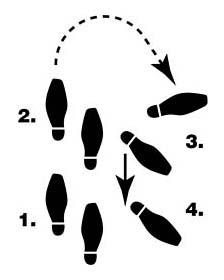
MARK 5320: Advanced Marketing Fundamentals
Chapter 13: Professional Selling
This chapter provides an overview of professional selling, with an emphasis on the role salespeople play in building customer relationships for the company and as part of the marketing team. Sales metrics, ethics in selling and outsourcing the sales function are also discussed.
Famous sales quotes:
"The object of a salesperson is not to make sales, but to make customers"
"Every sale has five basic obstacles: no need, no money, no hurry, no desire, no trust."
Salespeople act on behalf of their companies to do the following:

Salespeople are boundary spanners, in that they operate outside the firm and in the field. They are the first to learn about what competitors are doing. Important aspect of their job is to report back to the company about the competition's new offerings and strategies. Salespeople also get a lot of information from customers that will help the company create new offerings, adjust current offerings (Boundary spanner).
Salespeople can be categorized in a variety of ways; your text categorizes salespeople based on their activities.
Four types of salespeople: 1) missionary, 2) trade, 3) prospectors, and 4) account managers.
TYPES
A missionary salesperson calls on people who make decisions about products for their companies, but who don't actually buy them. Example: Sales representative may provide a doctor with clinical information about a particular drug in hopes that the doctor will prescribe it for his/her patients. But, it is actually the patient who purchases the drug.
Missionary salespeople may also call on "market influencers" or people who are in positions to recommend products to others.
A trade salesperson is someone who calls on retailers and helps them display, advertise and sell products to consumers.
A prospector is a salesperson whose primary function is to find prospects, or potential customers. This type of salesperson makes a lot of "cold calls," approaching people who may have a need for a product, but who are not actively looking for it yet. Many salespeople who sell to consumers fall into the category of prospectors. Examples: Avon and Mary Kay.
In some companies, the prospector finds the customer, then turns him/her over to another salesperson to close the deal. In other companies, the prospector works with the customer through the closing of the deal.
Account managers are responsible for ongoing business with a customer who uses a product. A new customer may be found by the prospector and then turned over to an account manager. Or, if new accounts are rare, the account manager may also perform prospector functions. Example: Taylor Bergstrom, Texas Ranger baseball team's sales representative. Bergstrom works with season ticket holders to ensure that they have a great experience over the course of a season.
Account managers are particularly responsible for developing relationships with lead users. Recall that lead users are in a good position to help improve a company's offerings and develop new ones.
Firms put a lot of time and energy into maintaining relationships with certain types of customers. Generally, large volume buyers, innovative lead users, and market influencers receive the most attention by salespeople. It is often more profitable to ship to a few large volume buyers than many small order customers. Lead users and market influencers often have the expertise and resources to assist the company in developing better offerings and influencing additional purchases.
Sales relationships operate along a continuum based on a level of intimacy and trust similar in other relationships. On one end is transactional relationship where there is little interest in an ongoing relationship. On the other end is a strategic partnership where the relationship is akin to a marriage. In a transactional sales relationship, each sale is a separate exchange and the two parties to it have little or no interest in maintaining an ongoing relationship. A functional relationship is a limited, ongoing relationship that develops when a buyer continues to purchase a product from a seller out of habit, as long as his/her needs are met. Affiliative selling relationship is one where a significant amount of expertise is needed from the seller and trust is an issue. Strategic partnership is one in which both the buyer and seller commit time and money to expand "the pie" for each other. This is the most involved relationship and is often compared to a marriage. The types of relationships are not a process—not every relationship starts at transactional and moves through function and affiliative to strategic. It is not the goal to make every relationship a strategic partnership. The level of the desired relationship is directly related to how "valuable" the customer is viewed to be to the company.
A salesperson's selling strategy differs depending on the type of relationship he/she has or wants with the customer. There are four selling strategies, ranging from script-based selling to strategic partnering.
Sales Process
Six Types of Sales People

Salespeople are evaluated upon several key metrics: Most important is the actual revenue generated. Sometimes the average revenue generated per customer and the average revenue generated per sales call are measured to determine if a salesperson is pursuing customers that are the most lucrative.How many prospects and suspects a salesperson has in the pipeline are two other measures. Conversion ratios measure how good a salesperson is at moving customers from one stage in the selling cycle to the next. For example, how many leads did a salesperson convert to suspects? A 10:1 ratio means it too 10 leads for the salesperson to get 1 suspect who agreed to move to the next step. Conversion ratios are used to measure success at all stages of the sales process and help the salesperson recognize which stages need improvement. They also help the salesperson estimate how many sales calls are needed in order to meet certain sales goals. Activity goals are how many sales calls of each type a salesperson has to make in a certain period. Win-loss analysis is an "after the battle" review of how well a salesperson performed given the opportunities faced. An analysis of what worked and what didn't is done. Another measure is the money a salesperson makes, either in the form of a bonus or commission. A bonus is usually paid at the end of a period of time based on total amount sold, whereas a commission is usually a per sale payment. Commissions are popular with short sales cycles and transactional selling strategies. Salaries with commissions or bonuses are more typical of sales that take longer and require more relationship-building.
Sales managers use previously mentioned metrics to evaluate salespeople but they also use sale cycle metrics to make broader decisions. Sales cycle metrics at the aggregate level can be very useful for making effective managerial decisions. Managers evaluate: performance of salespeople, effectiveness of sales message, market share the product captures,accuracy of forecasts for materials requirement planning purposes,costs related to sales, and customer satisfaction surveys.
This clip was used to replace a very humorous clip off twin babies by a refrigerator speaking – the translation was about sales management. If you can find the clip send me the URL. Until then this one will have to do.
A company can outsource all or part of the sales cycle. For example, a company may hire a call center to make the initial contact with the buyer and move the buyer from lead to suspect in the sales cycle. Independent agents are salespeople who are not employees of the company; they set their own hours, determine their own activities and are usually paid on commission. They often represent competing companies to the customer, such as in the insurance agency. A manufacturer's representative is an agent that sells the manufacturer's product and complimentary products and is hired because he/she already is selling in the desired market. Example would be an agent that sells bathroom faucets for one manufacturer and bathroom towel rods for another. Companies may hire distributors to receive and manage inventory and who have salespeople to complete the entire sales cycle.